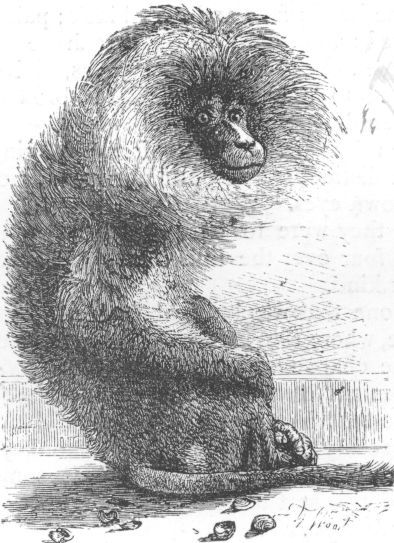| Page 8 | |
|
Natural History of the Mammalia of India and Ceylon - by Robert A. Sterndale F.R.G.S., F.Z.S. (1884) | |
| prev page next page | contents |
PAPIONINAE.
This sub-family comprises the true baboons of Africa and the monkey-like baboons of India. They have the stomach simple, and cheek-pouches are always present. According to Cuvier they possess, like the last family, a fifth tubercle on their last molars. They produce early, but are not completely adult for four or five years; the period of gestation is seven months.
The third sub-family of Simiadæ consists of the genera Cercopithicus, Macacus, and Cynocephalus, as generally accepted by modern zoologists, but Jerdon seems to have followed Ogilby in his classification, which merges the long-tailed Macaques into Cercopithecus, and substituting Papio for the others.
GENUS INUUS.
Cuvier applies this term to the Magots or rudimentary-tailed Macaques. The monkeys of this genus are more compactly built than those of the last. They are also less herbivorous in their diet, eating frogs, lizards, crabs and insects, as well as vegetables and fruit. Their callosities and cheek-pouches are large, and they have a sac which communicates with the larynx under the thyroid cartilage, which fills with air when they cry out.
Some naturalists of the day, however, place all under the generic name Macacus.

17. INUUS vel MACACUS SILENUS The Lion Monkey (Jerdon's No. 6).
NATIVE NAMES.—Nil bandar, Bengali; Shia bandar, Hindi; Nella manthi, Malabari.
HABITAT.—The Western Ghâts of India from North Lat. 14° to the extreme south, but most abundant in Cochin and Travancore (Jerdon), also Ceylon (Cuvier and Horsfield), though not confirmed by Emerson Tennent, who states that the silenus is not found in the island except as introduced by Arab horse-dealers occasionally, and that it certainly is not indigenous. Blyth was also assured by Dr. Templeton of Colombo that the only specimens there were imported.
DESCRIPTION.—Black, with a reddish-white hood or beard surrounding the face and neck; tail with a tuft of whitish hair at the tip; a little greyish on the chest.
SIZE.—About 24 inches; tail, 10 inches.
There is a plate of this monkey in Carpenter and Westwood's edition of Cuvier, under the mistaken name of Wanderoo.
It is somewhat sulky and savage, and is difficult to get near in a wild state. Jerdon states that he met with it only in dense unfrequented forest, and sometimes at a considerable elevation. It occurs in troops of from twelve to twenty.
